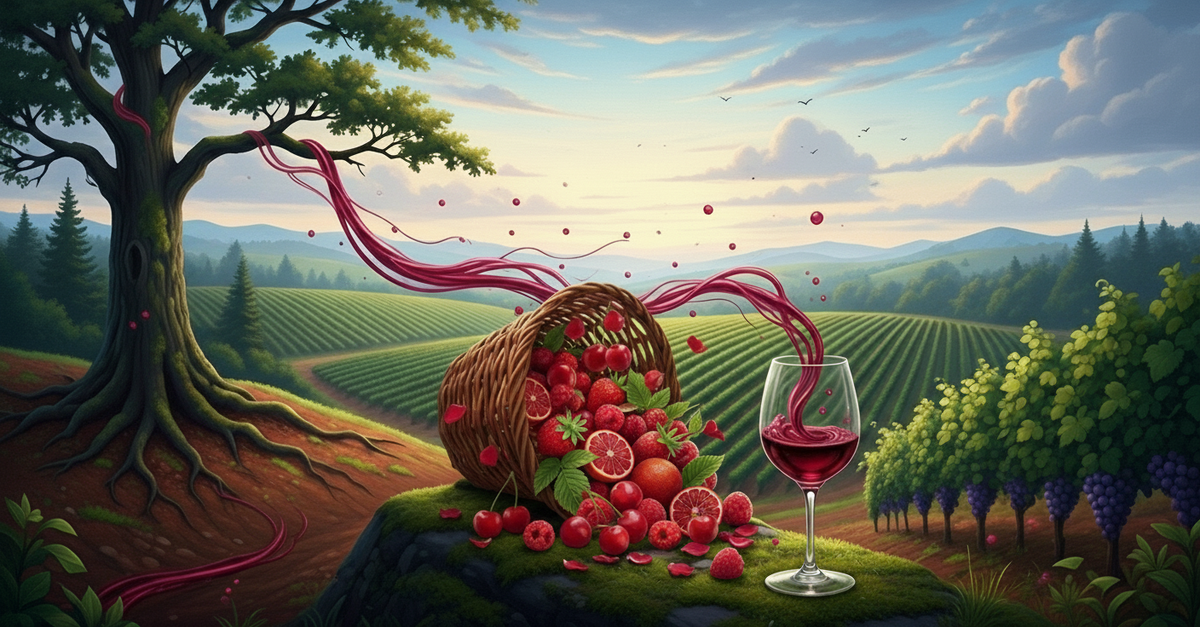2012 Willamette Valley: Sun-Polished Cherries That Keep Their Cool
Discover why Willamette Valley’s 2012 Pinot Noir became a modern benchmark: the curtain-lift vintage with sunny days, cool nights, clean fruit, and fine tannin. Get tasting notes, sub-region cues, style spectrum (stems, oak, ABV), producer standouts, and a clear drink-or-hold timeline.

A Dawn Question in Pinot’s Voice
Ever tasted a Pinot that steps out of afternoon sun with cherry on its sleeve, then slips into evening fir shade and straightens its collar with spice?
Curtain Lifts, Nights Keep the Pulse
Think of 2012 as the curtain lifting. The cool, tricky 2010 and 2011 pair bows out. A bright, even summer walks onstage, polishing cherry and keeping the night air’s cool hand on the pulse. Spring shakes off rain. Flowering sets clean and even. July and August run warm and dry without the kind of spikes that bruise perfume. Diurnal swings act like an invisible editor and tighten the prose. September stays kind. October allows unhurried picks. Fruit is clean. Clusters are sound. Seeds mostly brown. Growers chase ripeness without surrendering line. Rush and you miss silk. Linger and heat can smudge the outline. The best choices thread sunshine through acidity and let the valley speak.
Ripe Light, Calm Line
Willamette Valley 2012 Pinot Noir vintage—bookmark it. A modern benchmark. Ripe yet proportionate. Sunlight puts flesh on the bones and a confident cherry core in the middle. Night air steadies the pulse and preserves acidity, floral lift, and calm center. Versus 2010 and 2011 it reads more open armed. Against warmer later years it feels tidier, a chamber quartet rather than baritone. Tannins read as brushed suede, not armor. Oak frames the picture, never the furniture. Collectors pour it to show how Oregon Pinot can smile on release and still hold its line for years.
Silk Banner, Evening Wind
First impression is red in high resolution. Rainier cherry. Wild strawberry. A brush of raspberry leaf. Then rose petal and blood orange drift in with baking spice. The mid-palate feels like brushed suede. Supple. Fine grained. Quietly confident. Acidity moves like evening air through fir. It carries fruit forward and never hurries. Signature image. 2012 is a silk banner held taut by evening wind. Flow and shape at once. Alcohol often sits near the middle fours yet the best bottles wear it lightly. The valley’s forest grammar shows as cedar, fir tip, and black tea. With air the color deepens. Cola notes. Pomegranate molasses. A touch of clove. Never heavy. Just more ink in the same pen. Anthropomorphic aside. Pinot sidles in with cherry on its sleeve. It straightens its collar with cedar and tea. It is ready for conversation. Finishes are clean and persistent. More savor than sweetness. A faint mineral chalk. A memory of rose.
Hills, Winds, and Stone Speak
- Dundee Hills — Volcanic warmth and red-fruited charm. Jory soils translate to cherry, rose, and a soft glow of baking spice. Worden Hill benchlines show silk and lift.
- Eola–Amity Hills — Poise from the Van Duzer winds. Darker cherry and red currant ride a savory tea line. Frames feel firmer. Acidity stays lively. Finishes run long.
- Yamhill-Carlton — Marine sediment swagger. Blue-black fruit and cocoa nib. Suede tannin and broader middles that still close on mineral.
- Ribbon Ridge — Compact power with sap. Spiced cherry and resinous herb. Tactile grip that relaxes into satin.
- Chehalem Mountains — A chorus of slopes and soils. Red cherry to cranberry. White pepper. Stony undertow. Perfume holds even as structure shifts with aspect.
- McMinnville — Basalt edges and ocean breath. Dark cherry, plum skin, graphite. Cool lines. Quiet strength.
- Dark horse — Higher, wind-brushed parcels in Eola–Amity and Ribbon Ridge carried extra nerve in 2012. Brightness that outran the warmth.
Nouns of Sunlight, Syntax of Stems
- Whole cluster — Stems in the ferment add rose, clove, and herbal lift. They build a taller, more vertical tannin. Destemmed lots read as pure cherry and easy glide.
- New oak — Many cellars lived in the ten to thirty range. Lower oak keeps florals forward. Higher but careful use adds cocoa and toast to the edges without swallowing fruit.
- ABV reality — Many wines land between 13.5 and 14.2. Balance is the tell. Alcohol should warm the finish and not widen the middle into blur.
- Ferment choices — Cooler peaks protect high-toned cherry and citrus. Warmer peaks pull cola, tea, and depth.
- Net effect in 2012 — Sunshine writes the nouns. Cherry. Rose. Tea. Stems and oak adjust the syntax. Smart editing keeps freshness intact and lets tannin read as texture, not punctuation.
Icons, Values, Wild Hearts
Icons
- Eyrie Vineyards (Dundee Hills) — Historic finesse. Red fruit, flowers, and a length that speaks under its breath. Restraint multiplies detail in 2012.
- Beaux Frères (Ribbon Ridge) — Vineyard depth in seamless cloth. Spice and sap woven to satin.
- Cristom (Eola–Amity) — Single-vineyard clarity. Van Duzer lift. Savory thread. Frames that welcome time.
Value Plays
- Goodfellow Family Cellars — Mineral etched and tea leaf detailed. Honest sites at sane prices.
- Ayres (Ribbon Ridge) — Sappy cherry and gentle tannin. Bright and transparent.
- St. Innocent — Site first. Generosity balanced by line. Cellar friendly without shock.
Wild Cards
- Kelley Fox (Dundee Hills) — Perfume forward and feather touch. Roses and red citrus on a fine spine.
- Cameron (Dundee and Chehalem) — Savory old-world tilt. Forest floor and cherry with a dry mineral close.
- Antica Terra — Sculpted power with precision. Layered fruit and a saline stone finish.
Three Roads Through Time
- Early Charm (now to 2028) — Village and entry single-vineyard wines sit in a sweet place. Bright cherry. Rose lift. Tannins like suede. A short decant sharpens the focus.
- Sweet Spot (2029 to 2038) — Mid and top sites gather black tea and balsam. Fruit shifts from cherry to pomegranate and blood orange. Tannins dissolve to silk. Complexity steps forward.
- Marathon (2039 and beyond) — Best parcels with stem savvy and disciplined oak move into a savory hush. Dried rose. Tobacco leaf. Citrus oil. Cool earth. Acidity keeps the line. Finishes stretch and fade clean.
The Line Holds
2012 Willamette reads like cherry written in sun and edited by night air. The year gave clean fruit, fine tannin, and acidity that moves the wine without rushing it. That is why bottles show open arms on release and still gather detail with time. The chemistry is simple and beautiful. Long hang time built phenolic ripeness. Cool evenings kept pH in check. Stems, where used, added lift and a vertical frame. Oak stayed quiet and shaped, not shouted. Across hills and soils you feel the same theme: generosity with outline.
Think of aging here as a slow focus pull. Five to eight years bring black tea, cedar, and the faint smoke of fir. Ten to fifteen adds dried rose, citrus oil, and mineral calm. The fruit does not fade. It steps back and lets the landscape speak. If you want a north star for modern Oregon Pinot, this is it. Ripe light. A steady line. A story that keeps reading clean as the pages turn.





